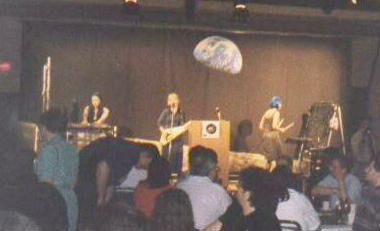We are developing the social individualist meta-context for the future. From the very serious to the extremely frivolous... lets see what is on the mind of the Samizdata people.
Samizdata, derived from Samizdat /n. - a system of clandestine publication of banned literature in the USSR [Russ.,= self-publishing house]
|
I’ve been watching a series on BBC-2 called “The Seven Industrial Wonders of the World”. Tonight’s episode was the story of the Hoover Dam which was built during the ‘made in Washington DC’ depression era of the 1930’s. The Beeb did a mostly bang-up job and filled in much interesting detail on the harsh and dangerous condition the workers endured.
They showed the Bosses versus the Union. The organizer and everyone with him got fired and run off the job site. Many workers had serious health disabilities caused by working in improperly ventilated tunnels with gasoline powered machinery packed to the rafters. The company claimed illnesses were pneumonia when they were plainly caused by Carbon Monoxide poisoning.
One worker sued and claimed, among other things, sexual dysfunction. The nasty old bosses set a prostitute on him… and she later testified in court that his function was quite satisfactory!
The Beeb told us the heroic Union organizer was from the IWW or International Workers of the World. The Wobblies. They left out a ‘minor’ detail: the IWW was a Communist front organization. I happened to be quite aware of who they were because I gigged in a Pittsburgh South Side Bar called “Wobbly Joe’s” for many years. To those not familiar with the Pittsburgh that once was, the South Side was Steel Worker country. [Remind me to tell you the story about the night I got my tires slashed after beating a local in an impromptu drag race in my souped up MGB]
The Wobbly’s of the 1930’s were widely known to be Communists. This is no conspiracy theory. They were Reds, pure and simple. Just try a google on the terms: “IWW Communist”.
I know how Communists operate albiet (fortuneately!) not as well as some here at Samizdata who grew up under them. If this was the source of information on the Union strife at the Hoover Dam, then the information is likely as truthful as a Pravda editorial. That the BBC neglected to inform the viewing audience of this places a very big question mark on all the rest of their historical information about the working conditions and worker mistreatment.
I do not doubt things described in the documentary could be true, but I require a more trustworthy source than 1930’s Marxist-Leninists to convince me.
Says Alice:
(I considered putting this on Samizdata, then thought maybe it wasn’t quite The Thing).
This is from Blackadder Goes Forth, a quite brilliant vintage British TV series set in WWI. Lord Flashheart is instructing a class of soldiers training to fly in the Royal Air Corps. Flashheart is the ludicrously loud and oversexed character played by Rik Mayall. George is the idealistic upper-class soldier played by Hugh Laurie.
And here it is:
Lord Flashheart: Treat your machine like you treat your woman!!
George: What, you mean, invite her home at weekends to meet your parents?
Flashheart: No! I mean, get inside her five times a day and take her to heaven and back!!
What a series that was.
There have been a great many animated films produced in the last 15 years. Many have been ordinary, but a surpringly large number have been good to wonderful. This article is an overview of these movies.
In the world of animation, once in a while see an animator or an animation studio going through a wonderful creative period. Over the last fifteen years, we have had three or four such hot patches. They do, I think, all owe a lot to the resurgence in animation that occurred due to the first of these, at Disney.
Until the late 1980s, Disney’s animation division had appeared to be in terminal decline. However, this somehow changed: Disney went through a stunning (but relatively brief) period of drawn animated musicals at the end of the 1980s and start of the 1990s, thanks to the wonderful musical work of Howard Ashman and Alan Menkin. In retrospect I think there were two great movies that came out of this, The Little Mermaid and Beauty and the Beast, but these changed animation forever. The two Disney movies that followed these (and which were as anticipated as they were because of them) were more financially successful, but I don’t think they were quite as good. Aladdin was an Ashman/Menkin movie, but the influence of Robin Williams made it a little uneven, in my opinion. And, very sadly, Howard Ashman was dying when he wrote the music, and it is not as finished and polished as on the earlier movies. The Disney movie that followed that was The Lion King, which had its music written by Elton John and Tim Rice, and although I think this movie is nicely made, it lacks the style of the earlier ones. After that, Disney’s drawn animation went into a steep decline, from which it has not recovered. (Just out of interest – the music and choreography of the first song – Going Through the Motions – of the musical episode of Buffy the Vampire Slayer is deliberately intended to look like a number from an Ashman/Menkin musical).
Financially, these four movies were extraordinarily successful. Prior to these movies, animation was considered to be something of a niche business, but these movies changed that idea utterly. They grossed far more than anyone had believed possible. Still, though, the audience was mainly children, and this fact made them some of the most financially successful films ever made. This was because they were made after VHS video recorders were ubiquitous. VHS video was a rental business, as people generally only wanted to watch movies once. However, the exception to this was films aimed at children. Children would (and will) watch the same movies over and over, and therefore parents would actually buy VHS tapes for their children. At the time, the prices of such tapes were high, and stunning numbers of the tapes of these four animated movies were sold. (Low quality direct to video sequels were made of these films as well, and these raked in even more). The films had not cost all that much to make (animation was not an art held in high regard just prior to The Little Mermaid) and the levels of profitability were just amazing. (The profit on The Lion King is in the billions of dollars, on an investment of maybe $50 million). Even better, children’s films are hugely valuable things in studio archives, as a new generation of children comes along every few years. (The Ashman/Merkin films also were helped by the fact that they coincided with the arrival of the baby boom echo generation of children. Hollywood was too dumb to be actually aware of this, and didn’t actually figure it out until after the release of the horror film Scream in 1996, but that is a different story, although one well worth telling some other time).
Disney’s competitors saw all this, and felt that they wanted a part of this profit. → Continue reading: Waiting for Miyazaki, or Thoughts on the state of animated movies.
I’ve just bought a new digital radio and it’s wonderful. Finally, I can receive BBC Radio 3 without analogical interruptions, which are perpetual where I live, in London SW1. You’d think that London SW1 would get good radio signals, wouldn’t you? But no. Too many towers? Too much electro-wizardry protecting the Queen and her Ministers? The weird weather conditions here in inner London? You tell me. (Truly, do tell me. We have a famously informed commentariat here.) Whatever the reason, until now I simply could not listen confidently to a Prom, say, without having to get up and fiddle with the damn radio every ten minutes, and as often as not all my fiddling would be powerless to stop the bonfire noises and the distortions.
But the new radio is fabulous. The sound is damn near as clean as a whistle, with no hint of an interruption. And it is especially fabulous when attached to my existing lo- to medium-fi CD playing system, thereby enabling me to tone down the treble and tone up the bass, which is how I prefer things. For some annoying reason, portable radios and CD players no longer seem to have treble or bass nobs built in to them. Is this the influence of the rise of Pop and the fall of Classical? (There goes another opportunity to distinguish yourself with a pertinent and informative comment.)
Talk of treble and bass makes me sound like a hi- rather than medium- to lo-fi-er. But so long as the sound meets my minimum quality threshold, I’m content, and my minimum quality doesn’t cost that much. The main thing is that treble/bass thing. I certainly don’t need to spend the many hundreds, thousands or even tens of thousands of pounds that you see mentioned in the review pages of hi-fi magazines, or in the hi-fi pages of the classical CD mags at the back, where loudspeakers look more like Daleks than the rectangular little boxes that I have.
The new radio is little handbag type object and it only cost a hundred quid, reduced by twenty at Dixon’s. It also has a built-in CD player, which means, what with my previous portable CD player having conked out, that I can now again play CDs quietly in my bedroom or living room, instead of having to switch up the main system in the kitchen whenever I want to listen outside the kitchen, and infuriate my neighbours. The treble/bass thing is a nuisance, but some kinds of music are more vulnerable to this limitation that others, so I’ll be fine. Harpsichord music, for example, doesn’t seem to worry about what would normally be too much treble.
So this is a quantum leap in my listening pleasure, like being given a vanload of unfamiliar CDs. And I also think that my pleasure throws light on three apparently rather separate sonic issues of the last few decades.
� First, hi-fi-ers were disturbed by what they regarded as the sonic imperfections of CDs compared with the old vinyl gramophone records.
� Second, the recording industry itself is infuriated by the apparent indifference of the public to the new Higher Figher formats like SACD.
� And third, there is the fact that the fastest growing sector of the music business is “historic” reissues on CD.
What gives? → Continue reading: Adequate sound is adequate: what matters is not being interrupted: thoughts on digital radio, SACD and the historic reissue business
This is an article about a movie that I rather like, but it is also about how not to write a film review.
I am werewolf, hear me roar… No, I am sure I remember that name of that daft Helen Reddy song all wrong, but that does seem to be the message of a review of Underworld in the Sierra Times by the colourfully named RadioFree Rocky D… this movie is just a pinko feminist tract.
To which I say… nonsense.

Underworld, the film in question, is in essence a version of Romeo and Juliette, but set against the backdrop of a war between not Montagues and Capulettes, but a clan of werewolves and a clan of vampires! This has everything for the trash movie aficionado: monsters, perpetual gloomy atmospherics, high tech weapons, chick-in-latex-with-guns (the breathtaking Kate Beckinsale)… need I say more? As an extra added bonus, it even has a decent and fairly complex storyline!
The review on the worthy Sierra Times dislikes this movie because it was being ‘politically correct’:
Women and men are physical equals. Anything a man can do, a woman can also do. Anyone who points out that men are physically stronger than women should be forced to undergo government-sponsored sensitivity training. Worse yet, telling the truth just may be sexual harassment. I know this, because Hollyweird tells me so.
I’m guessing that Beckinsale weighs in at a whopping 115 pounds – including her bootiliscious leather getup and her ho’ boots. I warm up with more weight than that. Be-otch come near me, and I’ll squish her. Good thing for her she carries twin Glocks.
Well for a start Selene, Beckinsale’s character, does not go mano-a-mano with the werewolves when she can avoid it… in fact she runs like hell to put some distance between them so she can shoot the hell out of them with silver bullets. And for another, she is not a 115 pound woman, she is a 115 pound immortal vampire, so why the hell should she be constrained by the limitations of a normal woman? I am sure that mighty jock RadioFree Rocky D could kick Kate Beckinsale’s delectable behind, but I doubt he is bulletproof regardless of how much weight he warms up with, so who cares?

The fact she casually steps off a ledge 20 floors up is a
fair indication the movie does not expect you to see
Selene as a feminist representation of ‘everywoman’
But then the review gets really weird:
More PC oozes out when someone wonders aloud, “Who started this war …?” This is Hollyweird’s way of saying that all wars are stupid and meaningless. Nothing could be further from the truth. Tell any veteran the war he fought in was for nothing, and you’ll get a face full of knuckles – and you’ll deserve it. Hollyweird has its hate-America-first panties in a bunch over the fact that President Dubya was the man at the helm when our troops totally stomped Saddam’s jackbooted civilian-killers into the sand. Where were the liberal’s objections when Weak Willie was Presidunce and sent troops to Bosnia, Somalia, Rwanda and Haiti? Where were the socialist street protests then?
Huh? Now I quite like the Sierra Times and no doubt RadioFree Rocky D and I would probably agree on a great many issues (I was an outspoken supporter of the armed overthrow of Ba’athism in Iraq for example), but this review is what happens when one’s ideology starts to distort everything one sees. That paragraph seems to suggest that to question the legitimacy and sanity of any war makes you some pabulum puking whining pinko. I guess RadioFree Rocky D must have thought any Russian who questioned the wisdom of the Soviet invasion of Afghanistan was some sort of weak kneed girly-boy.
And from this position he takes the view that questioning the wisdom of a war between vampires and werewolves is somehow criticism of the US/UK invasion of Iraq. Funny but I must have missed the ‘No Blood For Oil’ speech coming from one of the vampires (vampires… blood… get it? Oh never mind).

Use GUNS when fighting werewolves!
Anyway, this review tells us a lot about the author who rejoices in the name of ‘RadioFree Rocky D’ but tells us jack shit about the movie called Underworld… which happens to rock big time.

The ayes eyes have it!
Alex Singleton over on the Adam Smith Institute blog does not think much of the cinematic renditions of Lord of the Rings and asks:
Is the Lord of the Rings the most boring series of films ever? I sat through the second in the trilogy, The Two Towers, and just wanted to go to sleep. The pointless dialogue, endless battle scenes and lack of a story made this quite possibly the worst film I have ever watched at the cinema.
Well it takes all tastes but I for one enjoyed both Fellowship of the Ring and The Two Towers thoroughly and disagree with almost every word of Alex’s critique. The dialogue was true to the story, the battles gripping and best of all for me, the characters were almost exactly what I had in my head for over 30 years since I first read the books. In fact I think the films cut out a lot of the ‘flabby bits’ in Tolkein’s epic (such as editing out the completely superfluous Tom Bomberdil interlude) without doing a great violence to the substance of it.
Although as you may have gathered, I have long been a great fan of Tolkein’s works, the Lord of the Rings has always held deeper meanings for me and the big screen versions have just reinforced my views as to what it all really means.
I eagerly await the third part later this year.

Art criticism is something about which I only rarely touch on when something particularly interests me. But in today’s Sunday Telegraph (print version only), Ian Hislop has written an interesting piece called Now I’ll be labelled a pervert on how playwright Andrew Lloyd Webber has been scorned and derided by the British ArtCrit set because he has the temerity to not just collect Victorian and Pre-Raphaelite paintings, but to actually exhibit them to the public.
Having consented to display his collection at the Royal Academy last week, Webber was duly given a good kicking by the critics, who lined up rubbish both the pictures and their owner. The pieces ranged from the hysterical, in the case of Brian Sewell1, to the merely critical, in the case of the critic of this newspaper.
[…]
What appears to really annoy a lot of the critics is the literalism of the paintings: the idea that there is a story or a message, or even something as vulgar as a moral in the artwork, rather than just an impression or a mood or an emotion. Brian Sewell says that Webber has “a literal eye” and that this “has nothing to do with Art”. Nothing at all? This seems rather harsh
1= free registration required
And for me, therein lies the rub. Most art critics hate literal art because literal art can be understood by anyone who takes the time to learn a bit about the context within which the art was created. Now I am not someone who thinks ‘modern art’ is an oxymoron but it is true than much of what passes for art these days is so obscure that it requires an ArtCrit, such as Sewell or Saatchi, to give it some meaning. I guess what I am really saying is that much of what the likes of Tracy Emin does is so devoid of intrinsic meaning that only a professional arbiter of artistic values and taste can tell us poor muggles what the hell it means. No wonder art critics love ‘cutting edge’ modern art!
And now for some art you might be able to figure out for yourself…



The movie moguls and their sidekicks in the film industry are being urged to tone down their campaigning to win the forthcoming Oscars.
Presumably the heads of the film industry in the U.S. and elsewhere are concerned that an unseemly rush by actors, actresses and others to plug their films is already annoying the public. I honestly don’t know if people really are all that concerned if, say, Cameron Diaz or Russell Crowe are on the stump advocating the merits of their films. (If Ms Diaz wants me to interview her about her work, she is only too welcome).
The film industry, both in the States as well as elsewhere, has become so large in its financial strength that it is hard to see how much can, or should be done to restrain artists from doing their all to grab one of the golden statues. It may be crass, but what can you do, apart from ask for polite restraint? Personally, I nurse a slight antipathy to the Oscars, which usually provide an opportunity for blowhards like hard-left progagandist Michael Moore to harangue the audience with his paranoid views at the reward ceremonies, or else give the back-scratchers in the business a chance to do what they know best.
But really, in the big scheme of things, it is hard to get too upset. The Oscars have become a circus and they look set to remain that way, barring a catastrophic drop in the movie industry’s fortunes. Michael Jennings of this parish had some good things to say in this vein in his superb piece here a few days ago.
Of course the surreal nature of lobbying for Oscar slots gets even more Daliesque when juxtaposed next to the recall election in California. Here’s a poser for you – which is more out of touch with reality, the Oscars, or California’s politicians? Discuss.
It is the end of August, and the Labor Day holiday weekend is here. This is considered by the film industry to be the end of the summer movie season. Since Steven Spielberg invented the modern blockbuster when he made Jaws in 1975 (and due to the near-coincidental arrival of air-conditioning in most movie theatres), this has been the most important season for the Hollywood film studios. I am going to be mildly self-indulgent and give the readers of Samizdata a lengthy overview of what I think happened to Hollywood this summer, largely from a business point of view, but also from a creative point of view. This is going to be much longer than a normal Samizdata article, but I am assuming that my editors will indulge me just this once. Or maybe I shall receive what is known in Samizdata speak as an “editorial spanking”. We shall see. However, I think most of the following is quite interesting.
One sad fact is that I am in Britain, and films are usually released in this country anything from the same day as in the US to a couple of months after they are released in the US. Sometimes though it can be longer. What this means is that there are one or two big summer releases I haven’t seen. The most important of these is Finding Nemo, which is being held over until the holiday season here in the UK, despite being the highest grossing film of the summer in the US.
However, in order to explain why certain films are hits and some are not, an overview of recent year Hollywood economics is necessary. So, a little digression first.
→ Continue reading: Thoughts on Hollywood’s lousy summer
Ever since Instapundit pointed out, during all that faking of stories scandal, that the NYT may be politically all over the place on pages one, two, etc., but that on page n as n tends to infinity it has great technology coverage, I’ve been making a point of looking at that, and he’s right.
This, for example, from the New York Times today, sounds really interesting:
Standing on four metal legs, under two banks of fluorescent lights, was what appeared to be a modest-size billboard, measuring about 9 feet wide by 4 feet in height. Across its face, which looks like paper under glass, was a full-color advertisement for a soft drink maker. A few moments later the ad disappeared and was digitally replaced with a different one, and then another, like a screensaver cycling through images on a laptop computer screen.
But the surface of this billboard is not a liquid crystal diode screen – the energy-hungry display common to laptops and increasingly to cellphones, digital cameras, digital organizers and flat-screen computer monitors and television sets. Neither does this billboard share the light-emitting-diode technology that makes million-dollar-plus video screens light up the night in Times Square, Las Vegas and sports arenas around the world.
What makes the electronic billboard in Jersey City possible (and those installed for trials in London, Tokyo, Toronto and Panama City, among other locations) is an innovation by a New York-based display technology company whose name, Magink, is a combination of the words magic and ink. Its approach to imaging departs from the way most text, graphics and images are electronically presented, including the way expensive plasma screens work, as well as cathode-ray tubes, the old workhorses still found in most television sets and desktop computer monitors.
By creating a paste made of tiny helix-shaped particles that can be minutely manipulated with electric charges to reflect light in highly specific ways, Magink can produce surfaces that look like paper but behave like electronic screens, rendering high-resolution, full-color images without ink – or, as Magink executives like to refer to the process, with digital ink.
Ran Poliakine, chief executive of Magink, said the idea was to create visually compelling ads that could be replaced frequently – perhaps hourly, based on consumer response – and could be controlled remotely, all with far less energy and at a far lower cost than a video billboard.
It looks like paper. It’s cheaper than the usual screens, and easier to update. “Digital ink.” Wow.
I’m not any sort of techno-buff, but it sounds as if this technology differs radically from the usual screen technology in that it starts out being pretty big, but is rather hard to make small enough to fit on my desk. But they’ll get there, surely.
I don’t know about you, but when I am faced with a twenty page article on the internet, I do a print-out. Paper is just so much nicer than that screen shining so brightly at you. It’s the difference between reading something on the surface of a torch, and reading something on a surface. This stuff doesn’t shine light at you in an exhausting glare. It just reflects it, the way paper does.
It often happens that advertising cleans out the tubes of a new way of presenting messages, if only because novelty itself is the lifeblood of advertising – it gets your attention even if it does look cranky, because it looks cranky. Ten years later, it isn’t so cranky anymore and the advertisers are losing interest. But the R&D has had a big early contribution and Western Civilisation marches onwards. Just one more reason to love advertising.
Because what this really sounds like to me is the future of … reading!
Ah, the free market. Don’t you love it? When offered a Two Towers DVD at Victoria station by WH Smiths, on Friday, for £18.99, three days ahead of the supposed release date, I had to turn it down for three reasons:
- My mother-in-law, whom I was visiting in Worthing, has no DVD player.
- I didn’t want to have to go back to Victoria to change it, if it was scratched.
- I knew those nice people at Tescos would have a better deal, and I would be driving right past the Tescos in Henley on Monday, on the way back from Worthing.
And lo, the Two Towers two-disk set was mine, as I’d predicted, for a mere £11-99, provided I spent fifty quid on other Tesco items. Oh please, I never get out of there for less than a full ton (£100) these days, what with nappies, slim-line tonics, and Atkins’ diet steaks. So laughing all the way to the till, with a trolley load including two small steaks valued at my saving of seven pounds, I inwardly praised Adam Smith and the mysterious workings of the free market, before I bore the precious item home. → Continue reading: Lord of the DVDs: Thank God for Tescos
If you like your music with a positive, pro-technology and pro-future outlook, ZIA is the band for you.
ZIA has gigged successfully in the competitive New York City scene for nearly a decade. They have had their Rite of Passage: a review by The Village Voice. They developed a following and produced a number of excellent recordings. You can download a bunch of tracks from their web site and order any of the discography.
ZIA is 1990’s music, full of sythesizers and strange instruments. If you aren’t a cultural “old fart”, you’ll love it. Even if you are, you may still love the subject matter. They talk about settling Mars, going back to the Moon, winning the X-Prize and about the simple yearning of all us spacers… to get off this frigging planet. True, ‘filkers’ cover some of the same ground, but they and their material are not suitable for a Lower East music venue. Kids who haven’t even looked up at the seven or so stars in the nightime sky of Manhattan can drink and party to ZIA.
Full disclosure: I’m not exactly unbiased since I know the writer, Elaine Walker, and work with her in the National Space Society. Remember her name. Someday she’ll be running an industrial conglomerate in space.
 ZIA performance at 1999 International Space Development Conference
ZIA performance at 1999 International Space Development Conference
Photo: D. Amon, all rights reserved
PS: I understand Elaine is moving out of NYC, so I don’t know what is happening with the band. Watch their web site. I’m sure the information will show up there.
|
Who Are We? The Samizdata people are a bunch of sinister and heavily armed globalist illuminati who seek to infect the entire world with the values of personal liberty and several property. Amongst our many crimes is a sense of humour and the intermittent use of British spelling.
We are also a varied group made up of social individualists, classical liberals, whigs, libertarians, extropians, futurists, ‘Porcupines’, Karl Popper fetishists, recovering neo-conservatives, crazed Ayn Rand worshipers, over-caffeinated Virginia Postrel devotees, witty Frédéric Bastiat wannabes, cypherpunks, minarchists, kritarchists and wild-eyed anarcho-capitalists from Britain, North America, Australia and Europe.
|












